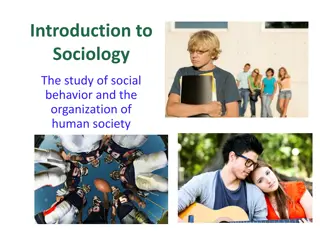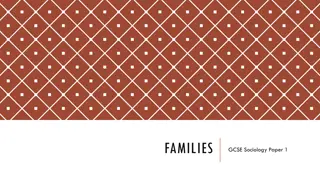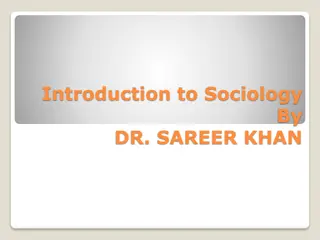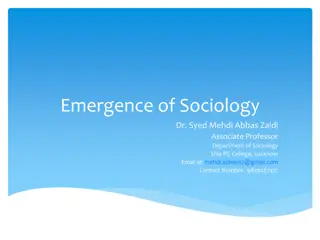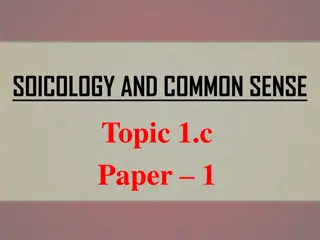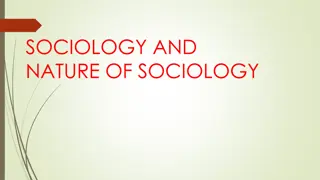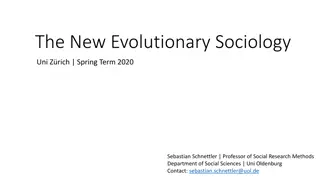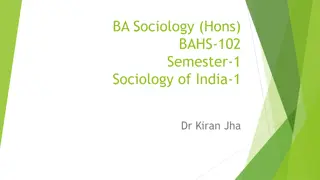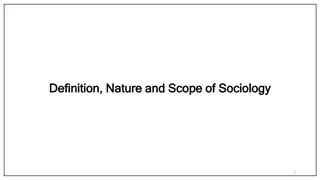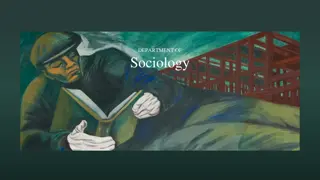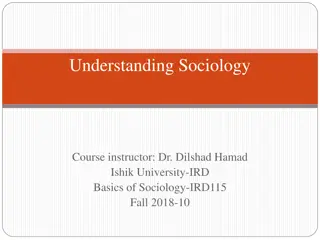Understanding Social Class in Sociology
Social class, also known as class, refers to a group of individuals in a society who share similar socioeconomic status. The concept of class plays a crucial role in social theory, influencing social mobility and census data. From early theories by political philosophers like Hobbes to Marx's influential ideas linking class to modes of production, the study of social class has been central to sociology's development.
Download Presentation

Please find below an Image/Link to download the presentation.
The content on the website is provided AS IS for your information and personal use only. It may not be sold, licensed, or shared on other websites without obtaining consent from the author. Download presentation by click this link. If you encounter any issues during the download, it is possible that the publisher has removed the file from their server.
E N D
Presentation Transcript
SOCIOLOGY SUSMITA ROY
SOCIALCLASS SOCIAL CLASS, ALSO CALLED CLASS, A GROUP OF PEOPLE WITHIN A SOCIETY WHO POSSESS THE SAME SOCIOECONOMIC STATUS. BESIDES BEING IMPORTANT IN SOCIAL THEORY, THE CONCEPT OF CLASS AS A COLLECTION OF INDIVIDUALS SHARING SIMILAR ECONOMIC CIRCUMSTANCES HAS BEEN WIDELY USED IN CENSUSES AND IN STUDIES OF SOCIAL MOBILITY. History and usage of the term The term class first came into wide use in the early 19th century, replacing such terms as rank and order as descriptions of the major hierarchical groupings in society. This usage reflected changes in the structure of western European societies after the industrial and political revolutions of the late 18th century. Feudal distinctions of rank were declining in importance, and the new social groups that were developing the commercial and industrial capitalists and the urban working class in the new factories were defined mainly in economic terms, either by the ownership of capital or, conversely, by dependence on wages
Early theories of class Theories of social class were fully elaborated only in the 19th century as the modern social sciences especially sociology, developed. Political philosophers such as Thomas Hobbes, John Locke and Jean-Jacques Rousseau discussed the issues of social inequality and stratification, and French and English writers in the late 18th and early 19th centuries put forth the idea that the nonpolitical elements in society, such as the economic system and the family, largely determined a society s form of political life.
This idea was taken farther by the French social theorist Henri de Saint-Simon, who argued that a state s form of government corresponded to the character of the underlying system of economic production. Saint-Simon s successors introduced the theory of the proletariat, or urban working class, as a major political force in modern society, directly influencing the development of Karl Marx s theory of class, which has dominated later discussion of the topic.
Karl Marx;s social theory of class For Marx, what distinguishes one type of society from another is its mode of production (i.e., the nature of its technology and division of labour), and each mode of production engenders a distinctive class system in which one class controls and directs the process of production while another class is, or other classes are, the direct producers and providers of services to the dominant class. The relations between the classes are antagonistic because they are in conflict over the appropriation of what is produced, and in certain periods, when the mode of production itself is changing as a result of developments in technology and in the utilization of labour, such conflicts become extreme and a new class challenges the dominance of the existing rulers of society.
The dominant class, according to Marx, controls not only material production but also the production of ideas; it thus establishes a particular cultural style and a dominant political doctrine, and its control over society is consolidated in a particular type of political system. Rising classes that gain strength and influence as a result of changes in the mode of production generate political doctrines and movements in opposition to the ruling class.
Contemporary theories of class Subsequent theories of class have been chiefly concerned with revising, refuting, or providing an alternative to Marxism. Early in the 20th century, German sociologist Max Weber questioned the importance of social classes in the political development of modern societies, pointing out that religious mores, nationalism, and other factors played significant roles. Weber proposed limiting the concept of class to impersonal income distinctions between groups, thereby distinguishing class from social status, collectivities, or political hierarchies.
But the Marxian emphasis on the importance of class conflicti.e., on the conflict and struggle between the classes for control of the means of production has been the most controversial issue dividing social theorists in their analysis of class structure. Many opponents of Marxist theory have focused attention on the functional interdependence of different classes and their harmonious collaboration with each other. And indeed, by the mid- 20th century, it seemed undeniable that the classes in capitalist societies had tended to lose some of their distinctive character, and the antagonism between them had declined to such an extent that in most economically advanced countries it no longer produced serious political conflict.
Characteristics of the principal classes Despite controversies over the theory of class, there is general agreement among social scientists on the characteristics of the principal social classes in modern societies. S ociologists generally posit three classes: upper, working (or lower), and middle. The upper class in modern capitalist societies is often distinguished by the possession of largely inherited wealth. The ownership of large amounts of property and the income derived from it confer many advantages upon the members of the upper class.
They are able to develop a distinctive style of life based on extensive cultural pursuits and leisure activities, to exert a considerable influence on economic policy and political decisions, and to procure for their children a superior education and economic opportunities that help to perpetuate family wealth. There are considerable differences within the working class, however, and a useful distinction exists between skilled, semiskilled, and unskilled workers that broadly corresponds to differences in income level. The middle class may be said to include the middle and upper levels of clerical workers, those engaged in technical and professional occupations, supervisors and managers, and such self-employed workers as businesspersons, and farmers. small-scale shopkeepers,
Characteristics of Class System: The following are the principal characteristics of class system: 1. A system of hierarchy of status. ADVERTISEMENTS: 2. A system of social ranking based primarily on economic position. 3. A system marked by unequal distribution of wealth and power. 4. A system more mobile than caste system. 5. A system in which status is achieved by one s own efforts rather than ascribed, assigned or inherited.
Differences between Class and Caste Systems In Max Weber s phraseology, caste and class are both status groups. While castes are perceived as hereditary groups with a fixed ritual status, social classes are defined in terms of the relations of production. A social class is a category of people who have a similar socio-economic status in relation to other classes in the society. In the caste system, status of a caste is determined not by the economic and the political privileges but by the ritualistic legitimation of authority. In the class system, ritual norms have no importance at all but power and wealth alone determine one s status (Dumont, 1958).
Following are the main differences between class and caste systems: Castes are found in Indian sub-continent only, especially in India, while classes are found almost everywhere. Classes are especially the characteristic of industrial societies of Europe and America. According to Dumont and Leach, caste is a unique phenomenon found only in India. Classes depend mainly on economic differences between groupings of individuals inequalities in possession and control of material resources whereas in caste system non-economic factors such as influence of religion [theory of karma, rebirth and ritual (purity-pollution)] are most important. Unlike castes or other types of strata, classes are not established by legal or religious provisions; membership is not based on inherited position as specified either legally or by custom. On the other hand, the membership is inherited in the caste system.
Class system is typically more fluid than the caste system or the other types of stratification and the boundaries between classes are never clear-cut. Caste system is static whereas the class system is dynamic. In the class system, there are no formal restrictions on inter-dining and inter-marriage between people from different classes as is found in the caste system. Endogamy is the essence of caste system which is perpetuating it. Social classes are based on the principle of achievement, i.e., on one s own efforts, not simply given at birth as is common in the caste system and other types of stratification system. As such social mobility (movement upwards and downwards) is much more common in the class structure than in the caste system or in other types. In the caste system, individual mobility from one caste to another is impossible.
This is why, castes are known as closed classes (D.N. Majumdar). It is a closed system of stratification in which almost all sons end up in precisely the same stratum their fathers occupied. The system of stratification in which there is high rate of upward mobility, such as that in the Britain and United States is known as open class system. The view that castes are closed classes is not accepted by M.N. Srinivas (1962) and Andre Beteille (1965). In the caste system and in other types of stratification system, inequalities are expressed primarily in personal relationships of duty or obligation between lower- and higher-caste individuals, between serf and lord, between slave and master. On the other hand, the nature of class system is impersonal. Class system operates mainly through large-scale connections of an impersonal kind. Caste system is characterised by cumulativeinequality but class system is characterised by dispersed inequality. Caste system is an organic system but class has a segmentary character where various segments are motivated by competition (Leach, 1960). Caste works as an active political force in a village (Beteille, 1966) but class does not work so.
REFERENCES INDIAN SOCIAL SYSTEM BY RAM AHUJA C.N.RAO SOCIOLOGY




